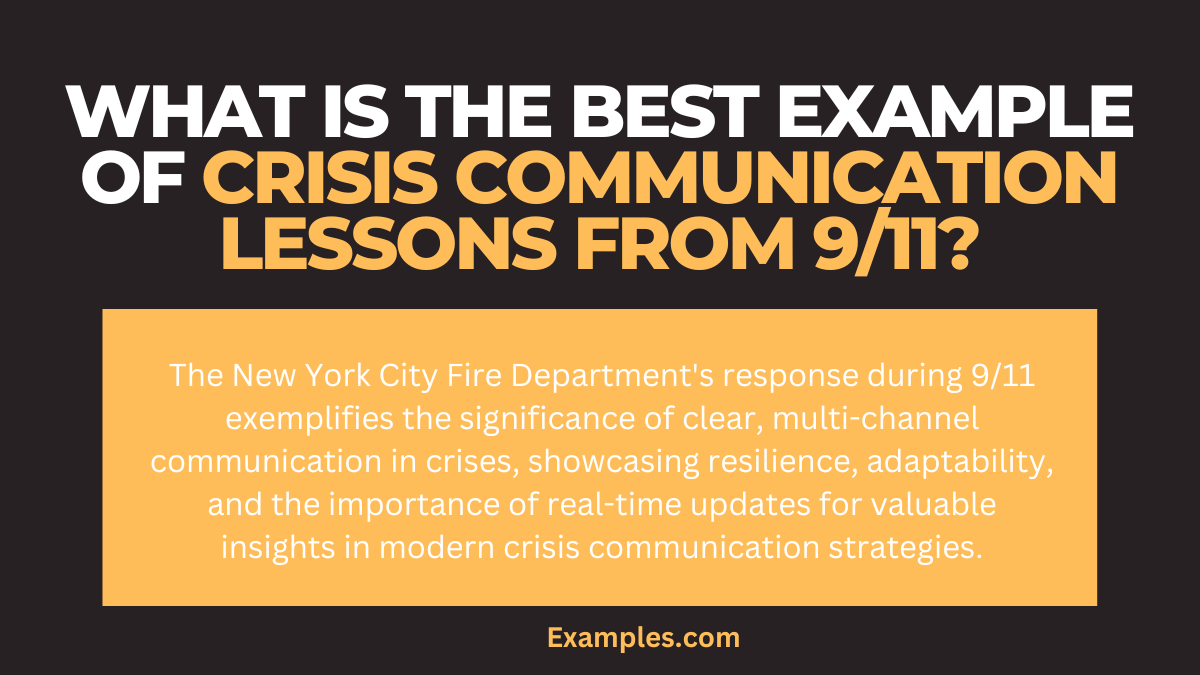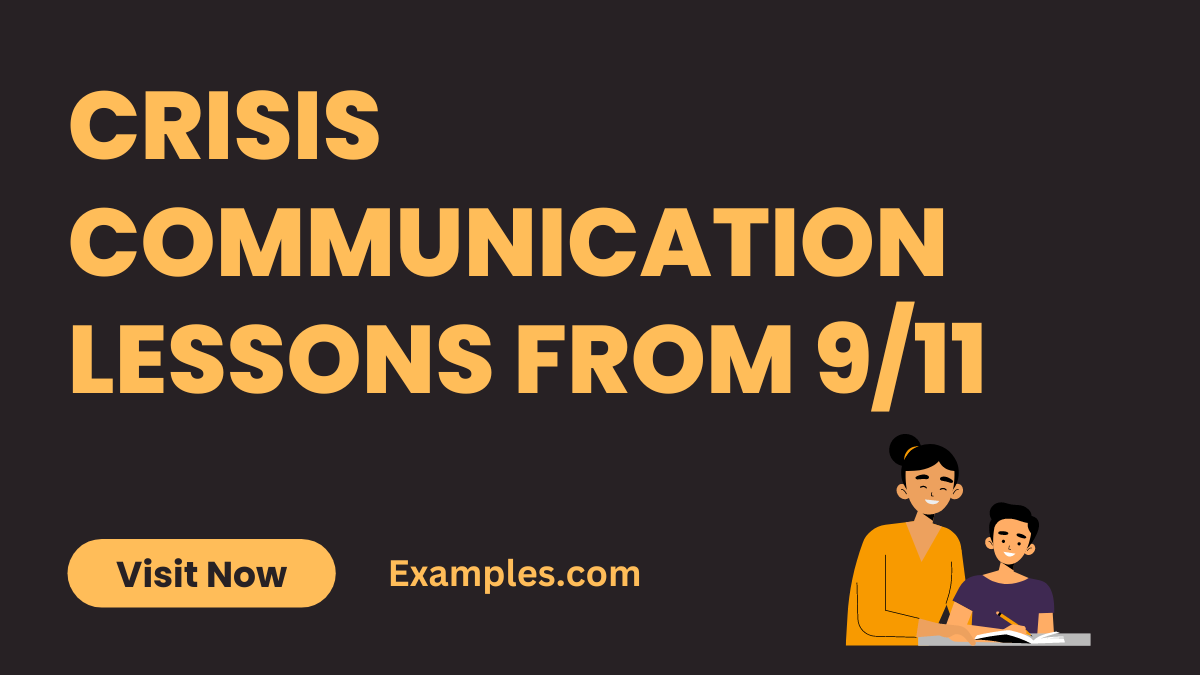19+ Crisis Communication Lessons From 9/11 Examples
Embark on a comprehensive exploration of Crisis Communication Lessons from 9/11 in this illuminating guide. Unveil impactful strategies, expert insights, and real-world Communication Examples, providing a profound understanding of navigating crises. Learn to wield effective communication in the digital age, drawing wisdom from one of history’s pivotal moments to fortify your approach and foster resilience. Discover actionable lessons for crafting compelling narratives and strategic responses in times of adversity.
What is Crisis Communication Lessons from 9/11?

Crisis Communication Lessons from 9/11 refer to the insightful takeaways derived from studying how communication strategies were employed during the tragic events of September 11, 2001. In simple terms, it encompasses the valuable lessons learned from analyzing the effective and, at times, challenging communication efforts in the aftermath of this historic crisis. Understanding these lessons aids in honing contemporary crisis communication strategies for navigating challenges in the digital age.
What is the Best Example of Crisis Communication Lessons from 9/11?

One standout example of effective Crisis Communication Lessons from 9/11 is the response by the New York City Fire Department. Faced with unprecedented challenges, they demonstrated resilience and adaptability in their communication approach. By utilizing various channels—radio, interagency communication, and public addresses—they provided real-time updates, crucial information, and maintained a sense of order. This case study exemplifies the importance of clear, multi-channel communication in times of crisis, offering valuable insights for modern crisis communication strategies.
20 Crisis Communication Lessons from 9/11 Examples

Delve into 20 illuminating Crisis Communication Lessons from 9/11, offering profound insights into effective strategies. Each example provides a unique perspective on navigating crises with wisdom, resilience, and strategic communication in the digital age.
- Unified Government Statements: Coordinate government statements for a unified voice, reassuring the public and conveying a sense of stability.
- Clear Evacuation Instructions: Provide clear and concise evacuation instructions, ensuring public safety and minimizing confusion during crises.
- Community Support and Solidarity Messaging: Foster community support through solidarity messaging, uniting individuals and fostering resilience.
- Responsive Media Interactions: Engage with the media responsively, ensuring accurate information dissemination and addressing concerns promptly.
- Timely Public Address Updates: Deliver timely public address updates, offering reassurance and keeping the public informed during unfolding events.
- Interagency Communication Coordination: Coordinate communication among various agencies, facilitating a cohesive and organized crisis response.
- Humanitarian Aid Communication: Effectively communicate humanitarian aid efforts, demonstrating empathy and showcasing support for affected individuals.
- Digital Platforms for Real-Time Updates: Leverage digital platforms for real-time updates, utilizing social media and websites to reach a broad audience swiftly.
- Corporate Collaboration for Relief Efforts: Collaborate with corporations for relief efforts, showcasing corporate responsibility and enhancing community support.
- Crisis Counseling Services Communication: Communicate the availability of crisis counseling services, providing emotional support for affected individuals and communities.
- Educational Institutions Crisis Plans: Develop and communicate crisis plans for educational institutions, ensuring the safety and well-being of students and staff.
- International Collaboration Messaging: Foster international collaboration messaging, demonstrating global solidarity and support in times of crisis.
- Infrastructure Restoration Updates: Provide updates on infrastructure restoration efforts, conveying progress and instilling confidence in the community’s recovery.
- Public Health Measures Communication: Communicate public health measures effectively, ensuring adherence and promoting community health and safety.
- Adaptive Leadership Communication: Exhibit adaptive leadership communication, adjusting strategies based on the evolving nature of the crisis.
- Clear Information Dissemination via Radio: Utilize radio for clear information dissemination, reaching diverse audiences with vital updates and instructions.
- Digital Memorialization and Remembrance: Establish digital memorialization efforts, fostering remembrance and honoring those affected by the crisis.
- Community Engagement Forums: Create community engagement forums, allowing open dialogue and addressing concerns to build trust and collaboration.
- Local Business Support Messaging: Communicate support for local businesses, fostering economic recovery and community resilience.
- Transparent Investigation Communication: Conduct transparent communication during investigations, addressing findings openly and maintaining public trust in the process.
Crisis Communication Lessons from 9/11 for Students Examples
Discover tailored Crisis Communication Lessons from 9/11 for students, providing insights into effective communication strategies amid academic challenges. Empower students to navigate crises with resilience and strategic communication in the digital age.
- Online Exam Disruptions Resolution: Address online exam disruptions promptly, providing clear instructions and alternative assessment plans for students.
- Remote Learning Technical Glitches Communication: Communicate technical glitches during remote learning transparently, offering solutions and ensuring a seamless virtual education experience.
- Supportive Mental Health Resources Messaging: Convey the availability of mental health resources, supporting students emotionally and fostering a positive online learning environment.
- Virtual Group Project Collaboration Guidance: Provide guidance for virtual group projects, ensuring effective communication, collaboration, and project completion.
- Student Outreach during Emergency Campus Closure: Reach out to students promptly during emergency campus closures, offering support, resources, and reassurance.
Crisis Communication Lessons from 9/11 for Interview Examples
Explore Crisis Communication Lessons from 9/11 tailored for interviews, providing essential insights into effective communication strategies during professional challenges. Elevate your interview communication skills and navigate crises with confidence.
- Adaptable Leadership Communication: Showcase adaptable leadership communication during interviews, emphasizing resilience and effective strategies learned from crisis experiences.
- Addressing Employment Gaps Transparently: Communicate employment gaps transparently during interviews, providing context and emphasizing skills gained during challenging times.
- Project Management Challenges Communication: Discuss project management challenges articulately, highlighting effective crisis communication strategies employed to ensure project success.
- Team Collaboration Amidst Crisis Experiences: Showcase teamwork and collaboration skills developed during crises, emphasizing adaptability and effective communication within a team.
- Conflict Resolution Strategies Highlight: Highlight conflict resolution strategies in past experiences, showcasing the ability to navigate challenges and maintain professional relationships.
Why is it important for people to know Crisis Communication Lessons from 9/11?
Understanding Crisis Communication Lessons from 9/11 is essential in today’s dynamic world. The unprecedented events of September 11, 2001, present a wealth of insights that transcend time. Learning from the communication strategies deployed during this crisis not only honors the past but equips individuals, organizations, and society with invaluable tools to navigate present and future challenges.
- Historical Significance: The events of 9/11 marked a turning point in modern history, making it crucial to learn from the communication responses deployed during this unprecedented crisis.
- Foundational Crisis Communication Principles: The crisis communication strategies employed during 9/11 laid the groundwork for modern crisis communication principles, offering timeless insights applicable in various contexts.
- Resilience Building: Studying how communication was managed during one of the most challenging moments in recent history provides a blueprint for building resilience in the face of adversity.
- Adaptability and Innovation: The dynamic nature of the 9/11 crisis required rapid adaptability and innovative communication approaches, offering lessons in thinking on one’s feet and navigating evolving situations.
- Global Implications: The global impact of 9/11 emphasizes the need for cross-cultural, global communication strategies—lessons that resonate in today’s interconnected world.
- Multi-Channel Communication: The crisis prompted the use of various communication channels, emphasizing the importance of a multi-faceted approach in reaching diverse audiences.
- Community Support and Solidarity: Crisis communication during 9/11 showcased the power of fostering community support and solidarity, lessons crucial for building resilience and unity in times of crisis.
- Digital Communication Strategies: The crisis unfolded in the early stages of digital communication, providing insights into the effective use of emerging technologies—an ever-relevant lesson in today’s digital age.
- Leadership Communication Skills: The crisis demanded strong leadership communication skills, highlighting the importance of transparent, empathetic, and decisive communication from leaders.
- Preparedness and Proactivity: Learning from 9/11 reinforces the significance of preparedness and proactivity in crisis communication, emphasizing the need for preemptive strategies and response plans.
In essence, delving into the Crisis Communication Lessons from 9/11 is not just an exploration of the past; it’s a journey to glean timeless insights that fortify individuals and organizations against the uncertainties of the present and future.
What were some lessons learned from 9/11 in Crisis Communication?
Several crucial lessons were learned from 9/11 in Crisis Communication, shaping the approach to managing and communicating during unprecedented events:
- Immediate and Transparent Communication: The importance of immediate and transparent communication became evident, ensuring timely information dissemination to the public and stakeholders.
- Adaptability and Agility: The dynamic nature of the crisis highlighted the need for adaptability and agility in communication strategies to respond effectively to rapidly evolving situations.
- Utilization of Multiple Communication Channels: The use of multiple communication channels, including traditional media, digital platforms, and interagency communication, showcased the importance of a multi-faceted approach to reach diverse audiences.
- Leadership Communication Skills: Effective leadership communication skills emerged as vital, emphasizing the need for leaders to convey reassurance, empathy, and a clear sense of direction during crises.
- Global and Cross-Cultural Communication: The global impact of 9/11 underscored the importance of global and cross-cultural communication, recognizing the need for nuanced approaches in diverse cultural contexts.
- Community Support and Solidarity Messaging: Crisis communication during 9/11 highlighted the power of fostering community support and solidarity, emphasizing the role of communication in uniting individuals and communities.
- Preparedness and Proactivity: The importance of preparedness and proactivity in crisis communication strategies was emphasized, urging organizations and authorities to have preemptive plans and response mechanisms in place.
- Digital Communication Strategies: The early stages of digital communication during 9/11 provided insights into the effective use of emerging technologies, setting the foundation for modern digital crisis communication strategies.
- Memorialization and Remembrance: Efforts in memorialization and remembrance became essential, showcasing the role of communication in honoring those affected and fostering a sense of collective remembrance.
- Collaboration and Information Sharing: Interagency communication and collaboration were critical, emphasizing the significance of sharing accurate information and coordinating efforts among different entities.
These lessons continue to resonate in contemporary crisis communication, serving as a guide for navigating challenges and fostering resilience in the face of adversity. The experiences from 9/11 have shaped crisis communication strategies, contributing to a more informed and adaptive approach in today’s interconnected world.
In conclusion, the Crisis Communication Lessons from 9/11 provide a profound guide for navigating contemporary challenges. The examples and comprehensive guide offer timeless insights into transparent, agile communication, adaptive leadership, and fostering community resilience. By honoring the past, this guide empowers individuals and organizations to effectively communicate, lead, and overcome adversities in our ever-evolving world.



